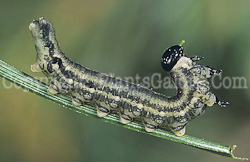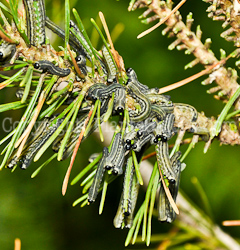|
 Each spring, about the first week of May, many pines are attacked by
what seem to be large swarms of green worms. This is the European pine
sawfly (Neodiprion sertifer) which was introduced into the
United States
in 1925. It is now a common pest of longer needle pines throughout the
northeast and north central states. Each spring, about the first week of May, many pines are attacked by
what seem to be large swarms of green worms. This is the European pine
sawfly (Neodiprion sertifer) which was introduced into the
United States
in 1925. It is now a common pest of longer needle pines throughout the
northeast and north central states.
It is not a true fly but rather belongs to a non-stinging group
of wasps. Although similar in form, the larvae are not
caterpillars.
Scotch (Pinus
sylvestris) and red (Pinus
resinosa) pine are most commonly attacked by this insect
but Eastern white (Pinus
strobus), mugo (Pinus
mugo) and Austrian
Pine (Pinus
nigra) may also be susceptible.
Life Cycle
 The eggs of the sawfly larvae are tan to brown and half-mooned
shaped. They may be found in rows of 6 to 8 eggs per needle on the previous
season's growth. Newly hatched larvae have a shiny black head capsule and
dark green body. When mature, they can be about 7/8 of an inch long. Their
bodies will be gray-green with several light and dark longitudinal stripes. The eggs of the sawfly larvae are tan to brown and half-mooned
shaped. They may be found in rows of 6 to 8 eggs per needle on the previous
season's growth. Newly hatched larvae have a shiny black head capsule and
dark green body. When mature, they can be about 7/8 of an inch long. Their
bodies will be gray-green with several light and dark longitudinal stripes.
Eggs are deposited in a series of slits cut in the needle by the
saw like ovipositor of the female in mid to late September. Larvae hatch
in early to mid-May and begin to feed on the old needles. As they get larger,
each larvae may eat entire needles and a group will strip all of the previous
year's needles. They do not feed on the current year's needles at the tip
of the branch.
The full-sized larvae drop to the ground where they pupate. The
adult saw flies emerge in September to mate and lay their eggs. There is
only one generation per year.
Since they only eat the previous year's foliage, the European sawfly
larvae are rarely fatal to the tree. In the rare case of massive numbers
over several consecutive years, trees could be stressed enough to die during
a drought or other additional stress.
In the case of Christmas trees, however, it is important to control
the damage of European sawfly since the loss of needles one or two season
before a tree is sale able size may reduce its value.
Control Alternatives
On small trees in the landscape, control may be as easy as directing
a strong spray of water onto the larvae and knocking them off the plant.
Insecticidal soaps or horticultural oils at summer rates may also be used
as an alternative.
Foliar sprays of
insecticides labeled for pine sawfly control
are also affective in severe infestations. One application should be enough.
The key is to look for the insect in early May as they begin to
feed on the older needles. They are very easy to kill at this time and
have done little damage. |



